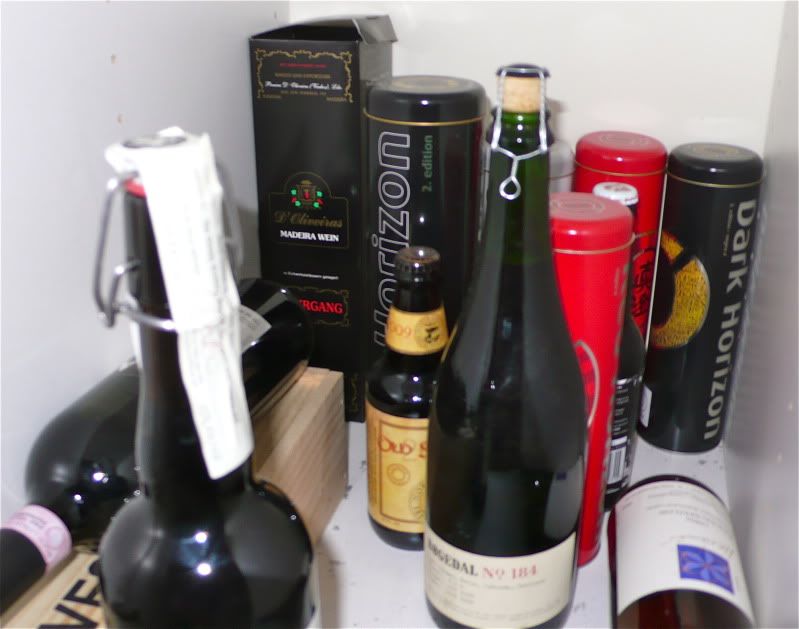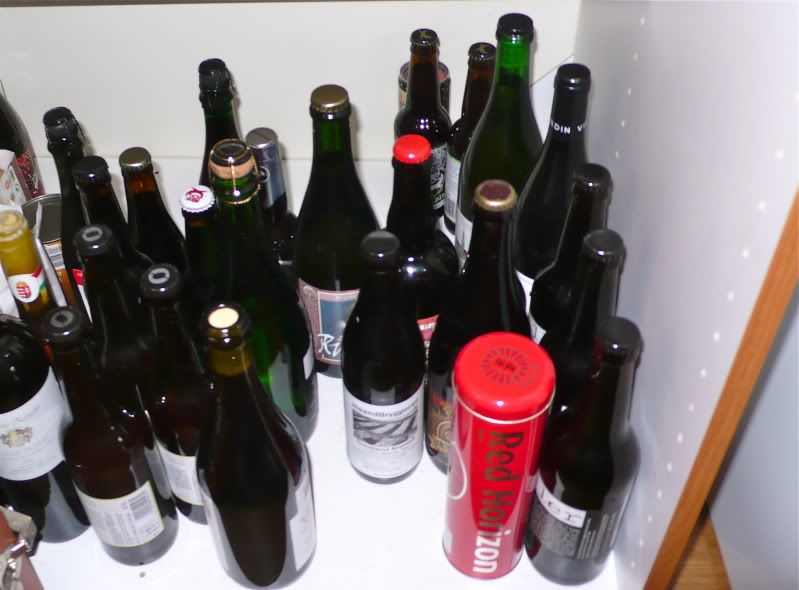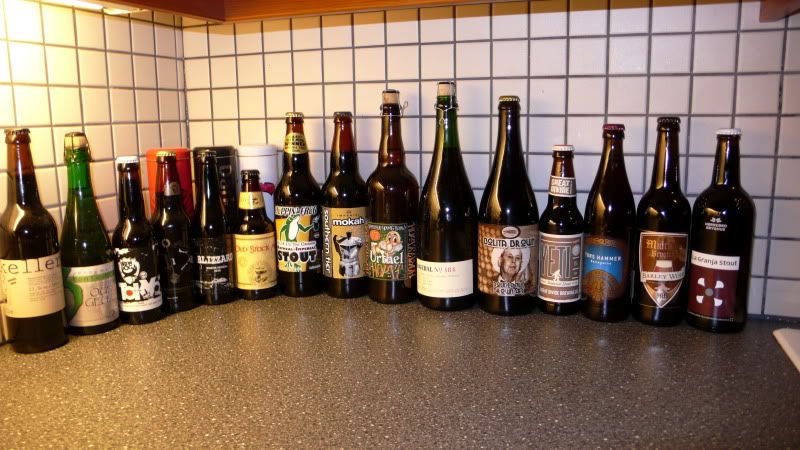Is anyone on here into Real Ales?
Posted by: Gale 401 on 07 April 2012
Whats your fav real ale?
Stu.
Hi Derry
Yeast does indeed need zinc. During the malting process protein is broken down into amino acids, which yeast uses to increase its cell wall size to enable it to bud and therefore propogate. Zinc is the only catalyst to do this, in the presence of oxygen available at the begining of the fermentation. Once the oxygen is used up, the yeast then begins to ferment, producing alcohol, and depending on temperature, various esters, which add the fruity notes people have mentioned.
As folk have mentioned there, there are fantastic regional variations in beer. A lot of that is due to the water. Hard water areas lead to drier, hoppier beers, such as Burton Pale Ales, soft water tends to give beer a more rounded, malty drinks, as the presence of calcium helps hop extract.
Now water comes from all over the place, and is treated so it is potable, sterile has flouride etc, so nearly all breweries have to treat water to make it suitable for brewing.
Calcium needs to be present in water to allow yeast to bond to finings, which is known as the lock and key effect, which settle out in the cask, leaving bright clear beer to our delight.
I have had to train two German brewmiesters in the subject of finings as they dont use them, they simply filter their beer. They advised me about zinc blocks, I have no reason not to believe them.
Sorry lots get back on subject.
Titanic Stout
Sarah Hughes Dark Ruby
Sherperd Neame 1696 ( think the numbers right!)
Kindest regards
Guy
You are so wrong I hardly know where to start.
Yeast absolutely does not need zinc blocks to do anything. It produces alcohol both aerobically, the first days of fierce fermentation, and anaerobically, the latter days of quieter fermentation.
Malting is the process where barley is encouraged to germinate to produce starch. During the mash enzymes in the malt convert starch to fermentable sugars which the yeast converts to alcohol and CO2. No addeed zinc, or any zinc is required.
As to water, both calcium sulphate and magnesium sulphate are important. Calcium sulphate because it acidifies the wort; magnesium sulphate because yeast likes it and it is good for producing pale ales.
Finings are not essential in home brewed beer and are used in commercial beer because the beer is moved quite frequently before sale. There are 2 types of fining - isinglass which you have mentioned already and alginate finings. Both work on an ionic principle, one attracts negatively charged particles, the other positively charged particles.
I am a bit troubled that your are teaching German brewers, or any brewers such stuff. Why German brewers would need training in finings or would throw zinc into a fermenter is quite beyond me.
p.s. Did you not used to be a brewer?
Yeasts require a range of metals for optimal growth, metabolism and fermentation performance. In production of fermented beverages, zinc is of prime importance, with levels of at least 0.3 ppm preferable for optimal fermentation and avoidance of stuck ferments. Zinc is a co-factor for numerous important biosynthetic and metabolic enzymes including, significantly, various glycolytic enzymes and alcohol dehydrogenase. In addition it plays critical regulatory roles through the action of Znfinger DNA binding proteins, and affects yeast-yeast flocculation. Zinc is also known to modulate yeast stress responses, mainly due to its role as a co-factor for the antioxidant enzyme superoxide dismutase. Furthermore, zinc ions are thought to have some effects on stability and dynamics of cell membranes, which may lead to downstream effects on cell permeability and signalling systems. In brewing fermentations, zinc is actively assimilated by yeast from malt wort. However, in most instances its bioavailability may be limiting due to decrease of zinc levels during mashing, lautering and boiling through complexing in precipitated trub. Consequently low zinc levels in wort may lead to slow and incomplete fermentations.
Read up!!!
Its entirely logical that German brewers (and there are some bloody good ones) need training in that area, if they come to the UK to brew and have never used finings.
I dont want the post to be too long and apologies for the hijack.
Malting does not encourage barley to produce starch, it is already there, encapsulated in a protein honeycomb matrix. Malting serves to (yes encourage germination) break down this matrix. These proteins are sub divided into the categories of polypeptides, hydrophobic polypeptides (which create the head on your beer/ale/lager) and the simplest, amino acids. this is started by steeping the grain in water, sometimes with low levels of gibberillic acid, but is normally present in the grain to 'wake' the grain from dormancy, by stimulating the aleurone layer, this then releases the enzymes that break down the protein, releasing the starch. The grain would start to then break down the starh into sugar, which you correctly allude to.
Your statement on water is correc it does acidify the wort ideally 5.3 to 5.5pH, but as I mentioned earlier, and forgive me for generalising (or dumbing down) does bear out the beer styles originating from differing areas, because the water has differing ionic balances.
During mashing, once you have the acidity you need for your beer style, yes enzymes get to work, alpha and beta amylase, (wont go into the others, such as limiting dextrinase), these two enzymes have differing properties, a-amylase breaks down straight chain linkages (if you know the structure of glucose, fructose etc will know they are a 6 long carbon chain) and are joined at carbon 1 and 6.
Beta amylase, which is very temperature and pH sensitive, breaks down the branched 1-4 linkages, if this is denatured by mash pH and temp, this will alter the sugar profile of your resulting wort. you can have more dextrins, complex sugars that saccharomyces cerevisiae, or indeed carlsbergenesis (lager yeasts) cannot metabolise, therefore creating 'body' and mouthfeel, but not sweetness in beer.
Quote 'Magnesium sulphate because yeast likes it.'
in single celled organisms such as bacteria and yeast low levels of Mg manifests itself in greatly reduced growth rates, in yeast excess Mg gives rise to mutation as yeast is a eucarite, which means it has 18 chromasones and therefore DNA.
As to finings Derry, yes I'm well aware of their composition, what they act upon, at what stage, and at what addition rate.
There are numerous, not two types of finings, yes in the context of primary (auxillary alginates, which are a type of fining I mentioned!), and secondary you can use gelatine instead of isinglass, plus vegan approved finings.
Then there's the third!
There are also copper finings (carragenan) to aid 'hot break' (wont bore you) that are derived from seaweed.
Oh yes, ionic principle and fining interaction, the ion involved is Ca2++, Calcium. Yeast would not have a charge without it!
Full apologies to the OP.
Kindest regards
Guy
PS: where was I wrong?
Hi Ptangyang
Thank you for the offer!
Regards
Guy
Not just ales..





I'm opening a little microbrewery and pizza restaurant in Hackney Wick next month called Crate. Come say hello if you happen to be passing!
Will you be doing a ploughmans pizza?![]()
Stu.
Hi Chalshus
Weyermann malt! They truly have an impressive portfolio of products for brewing!
I met their UK sales representative in light of a brewing conference few weeks ago, they have products that UK maltsters have long forgotten, that were used in British brewing and no longer made because the trends in UK brewing. Without them certain styles of beer could not be produced!
If you have 25Kg bags of malt, do you brew at home?
If so, I could send you some interesting hops to go with your malt.
Pilsner malt? Amarillo (10%) or Pacific Gem (26% alpha), maybe Magnum? Admittedly, I don't know the availability or diversity of hops in Norway, or indeed import restrictions.
Regards
Guy
I'm opening a little microbrewery and pizza restaurant in Hackney Wick next month called Crate. Come say hello if you happen to be passing!
Will you be doing a ploughmans pizza?![]()
Stu.
Not soon enough for me.
He said,As his arm came over the stumps to deliver yet another wonderful ball.
Stu.
Substitute alpha for beta amylase on one of my previous posts, before I'm corrected.....................
Another vote for Church End Brewery,
Vale brewery Haddas Spring Gold
Liverpool Organic 24 Carat Gold
I've been brewing with some friends a few times.
I have not brewed at home before. But I will, soon.
Ptangyang, I wish you well with your venture. I am fascinated with brewing. I try and visit my local brewery when I can and get a tour by the head Brewman and a few hours in the tasting room ![]() .
.
A few things that Brewman impresses on me:
a) East Anglia has some of the best brewing malt in the world and as a result is apparently exported around the world at a premium. (apparently to do with soil and climate).
b) the ingredient that is primarily responsible for the particular taste (as opposed to aroma) of the beer is the yeast and the extent the malt is fermented, and the yeast culture of a brewery or a licenced brew process is both delicate and guarded.
So with your microbrewery Id be interested to hear how you are deriving your yeast culture? Perhaps blending some un pasteurised samples of your favourite beers???
Simon
hi simon
thanks for those comments. very early days for me as a brewer, so i've not gotten into the intricacies of yeast selection etc, thats all to come. i've employed some master brewer advice to get us up and running with some excellent quality beers, once those are established i'll start the serious experimentation!
cheers!
I've been brewing with some friends a few times.
I have not brewed at home before. But I will, soon.
The Grosch bottles are great for home brew.

I have a few crates of the old brown ones in my shed left over from my home brewing days.
They can be washed and re-used many times.
Stu.
3 door's down from me 3 ales in one pub 300 yards around the corner 2 ciders (real ones) and 2 more ales think thats called pub heaven ![]()
